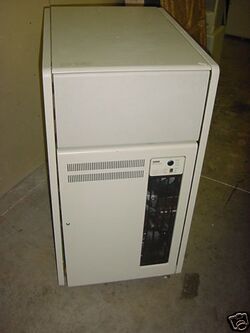Difference between revisions of "PDP-11/84"
m (→External links: +Preliminary PDP-11/84 System Technical and Reference Manual) |
m (Missed another /83 image) |
||
| (3 intermediate revisions by the same user not shown) | |||
| Line 1: | Line 1: | ||
| − | The '''PDP-11/84''' is the [[UNIBUS]]-capable twin to the [[QBUS]]-only [[PDP-11/83]]; both used the [[KDJ11-B CPU]] (with its [[Private Memory Interconnect|PMI]] bus). The -11/84 added a [[KTJ11-B UNIBUS adapter]] to provide its UNIBUS, and | + | [[Image:PDP11-84.JPG|thumb|right|250px|A PDP-11/84]] |
| + | |||
| + | The '''PDP-11/84''' is the [[UNIBUS]]-capable twin to the [[QBUS]]-only [[PDP-11/83]]; both used the [[KDJ11-B CPU]] (with its [[Private Memory Interconnect|PMI]] bus). The -11/84 added a [[KTJ11-B UNIBUS adapter]] to provide its UNIBUS, and required a custom main [[backplane]], the [[KDJ11 PMI/UNIBUS backplane]], to support it. | ||
== hampage.hu == | == hampage.hu == | ||
| − | + | ||
Quoting: | Quoting: | ||
<i> | <i> | ||
| Line 9: | Line 11: | ||
The UNIBUS-based PDP-11/84 was for those customers, who wanted more I/O throughput or had some legacy equipment. | The UNIBUS-based PDP-11/84 was for those customers, who wanted more I/O throughput or had some legacy equipment. | ||
| − | The box | + | The box used was the BA123 which was a popular enclosure for QBUS machines. Apart from the 12x4-slot QBUS backplane, it had five slots for storage units, e.g. room for two or three hard disks, a tape drive ([[TK50]] here) and floppy. |
</i> | </i> | ||
| + | <!-- | ||
| + | <br clear=all> | ||
== Gallery == | == Gallery == | ||
| − | + | --> | |
| − | |||
| − | |||
| − | |||
==External links== | ==External links== | ||
| Line 23: | Line 24: | ||
* [http://www.bitsavers.org/pdf/dec/pdp11/1184/EK-1184A-MG-001_1184maint_Nov86.pdf PDP-11/84 System Maintenance Guide] (EK-1184A-MG-001) | * [http://www.bitsavers.org/pdf/dec/pdp11/1184/EK-1184A-MG-001_1184maint_Nov86.pdf PDP-11/84 System Maintenance Guide] (EK-1184A-MG-001) | ||
* [http://www.bitsavers.org/pdf/dec/pdp11/1184/MP-02015-01_11-84_Maintenance_Print_Set_198412.pdf 11/84 Field Maintenance Print Set] (MP-02015-01) | * [http://www.bitsavers.org/pdf/dec/pdp11/1184/MP-02015-01_11-84_Maintenance_Print_Set_198412.pdf 11/84 Field Maintenance Print Set] (MP-02015-01) | ||
| + | * [http://bitsavers.org/pdf/dec/pdp11/handbooks/PDP-11_Systems_Handbook_1987.pdf PDP-11 Systems Handbook] | ||
{{PDP-11}} | {{PDP-11}} | ||
[[Category: UNIBUS PDP-11s]] | [[Category: UNIBUS PDP-11s]] | ||
Latest revision as of 12:35, 10 October 2024
The PDP-11/84 is the UNIBUS-capable twin to the QBUS-only PDP-11/83; both used the KDJ11-B CPU (with its PMI bus). The -11/84 added a KTJ11-B UNIBUS adapter to provide its UNIBUS, and required a custom main backplane, the KDJ11 PMI/UNIBUS backplane, to support it.
hampage.hu
Quoting: Introduced in 1988. Based on the J-11 chip set, DEC originally wanted the clock speed to be 20MHz, but it couldn't be done on time, so the actual speed was 18MHz. It was the fastest CPU of the PDP-11's anyhow. The high-end configuration had up to 4MB RAM on PMI (Private Memory Interconnect) and a floating-point accelerator.
The UNIBUS-based PDP-11/84 was for those customers, who wanted more I/O throughput or had some legacy equipment.
The box used was the BA123 which was a popular enclosure for QBUS machines. Apart from the 12x4-slot QBUS backplane, it had five slots for storage units, e.g. room for two or three hard disks, a tape drive (TK50 here) and floppy.
External links
- Preliminary PDP-11/84 System Technical and Reference Manual (EK-1184E-TM-PR1)
- PDP-11/84 System Technical and Reference Manual (EK-1184E-TM-001)
- PDP-11/84 System Maintenance Guide (EK-1184A-MG-001)
- 11/84 Field Maintenance Print Set (MP-02015-01)
- PDP-11 Systems Handbook
| v • d • e PDP-11 Computers and Peripherals |
|---|
| UNIBUS PDP-11s - PDP-11/20 • PDP-11/15 • PDP-11/35 • PDP-11/40 • PDP-11/45 • PDP-11/50 • PDP-11/55 • PDP-11/70 PDP-11/05 • PDP-11/10 • PDP-11/04 • PDP-11/34 • PDP-11/60 • PDP-11/44 • PDP-11/24 • PDP-11/84 • PDP-11/94 QBUS PDP-11s - PDP-11/03 • PDP-11/23 • PDP-11/23+ • MicroPDP-11/73 • MicroPDP-11/53 • MicroPDP-11/83 • MicroPDP-11/93 QBUS CPUs: LSI-11 • LSI-11/2 • KDF11-A • KDF11-B • KDJ11-A • KDJ11-B • KDJ11-D • KDJ11-E Buses: UNIBUS • UNIBUS map • SPC • MUD • EUB • QBUS • CD interconnect • PMI Also: PDP-11 architecture • PDP-11 Extended Instruction Set • FP11 floating point • PDP-11 Memory Management |
| UNIBUS CPUs: KA11 • KC11 • KB11-A • KB11-B • KB11-C • KB11-D • KD11-A • KD11-B • KD11-D • KD11-E • KD11-EA • KD11-K • KD11-Z • KDF11-U
Co-processors: FP11-A • FP11-B • FP11-C • FP11-E • FP11-F • KE44-A • FPF11 Chips: LSI-11 • KEV11-A • KEV11-B • KEV11-C • F-11 • KEF11-A • KTF11-A • T-11 • J-11 • FPJ11 CPU options: KE11-E • KE11-F • KJ11-A • KT11-C • KT11-D • KK11-A • KK11-B • KT24 • KTJ11-B Rare CPU options: KS11 Memory Protection and Relocation option • KT11-B Paging Option • KUV11 Writeable Control Store Front panels: KY11-A • KY11-D • KY11-J • KY11-LA • KY11-LB • KY11-P More on buses: UNIBUS and QBUS termination • Bus Arbitration on the Unibus and QBUS • CTI BUS PDT-11s - PDT-11/110 • PDT-11/130 • PDT-11/150 CTI PDP-11s - PRO-325 • PRO-350 • PRO-380 Other: FIS floating point • PDP-11 Commercial Instruction Set • PDP-11 stacks • PDP-11 family differences |
